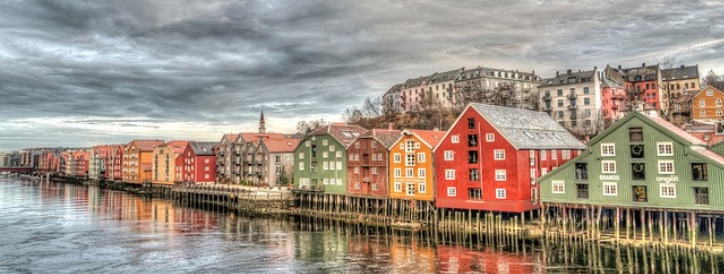2024 Norway Vacation Guide
In many ways, Norway is still a land of unknowns. Quiet for a thousand years since the Vikings stamped their mark on Europe, the country nowadays often seems more than just geographically distant. Beyond Oslo and the famous fjords, the rest of the country might as well be blank for all many visitors know – and, in a manner of speaking, large parts of it are. Vast stretches in the north and east are sparsely populated, and it is possible to travel for hours without seeing a soul.
Despite this isolation, Norway has had a pervasive influence. Traditionally its inhabitants were explorers, from the Vikings to more recent figures like Amundsen, Nansen, and Heyerdahl, while Norse language and traditions are common to many other isolated fishing communities, not least northwest Scotland and the Shetlands. At home, too, the Norwegian people have striven to escape the charge of national provincialism, touting the disproportionate number of acclaimed artists, writers, and musicians (most notably Munch, Ibsen, and Grieg) who have made their mark on the wider European scene. It’s also a pleasing discovery that the great outdoors – great though it is – harbors some lively historical towns.
Beyond Oslo, one of the world’s most prettily sited capitals, the major cities of interest are medieval Trondheim, Bergen, on the edge of the fjords, and hilly, northern Tromsø . None is exactly supercharged, but they are likable, walkable cities, worth time for themselves as well as being on top of the startlingly handsome countryside. The perennial draw is the western fjords – every bit as scenically stunning as they’re cracked up to be. Dip into the region from Bergen or Åndalsnes, both accessible directly by train from Oslo, or take more time and appreciate the subtleties of the innumerable waterside towns and villages. Further north, the stunning Lofoten Islands are worth a trip for their calm atmosphere and sheer beauty. To the north of here, Norway grows increasingly barren, and the tourist trail focuses on the long journey to the North Cape, or Nordkapp – the northernmost accessible point of mainland Europe. The route leads through the province of Finnmark , a vast, eerily bleak wilderness where the Arctic tundra rolls as far as the eye can see, and one of the last strongholds of the Sami and their herds of reindeer, which you’ll see right across the region.
Top Attractions in Norway
Jostedalsbreen Glacier
The Jostedalsbreen glacier is an 800-square-kilometer ice plateau whose chilly tentacles edge out into the surrounding valleys. A guided walk on the Jostedalsbreen can be one of the most memorable experiences of any visit to Norway.
Trondheim
Trondheim is one of Norway’s most enjoyable towns, a bustling place with excellent restaurants, nightclubs, and perhaps the finest historic building in the whole of the country, the imposing Nidaros Cathedral, parts of which date from the eleventh century.
Viking Ships Museum
Oslo’s Viking Ships Museum possesses two beautifully preserved Viking longships, retrieved from ritual burial mounds. There’s even a spectacular hoard of Norse treasure to go with them, including a couple of exuberantly carved ceremonial sleighs.
Nordkapp (North Cape)
Wind-battered Nordkapp is Europe’s northernmost point, an exhilaratingly bleak clifftop overlooking the waters of the Arctic. Probably, the North Cape is the main attraction in Norway. It is also known as the northernmost point of Europe. Visiting the North Cape can be a beautiful experience. You can also enjoy over 2 million seabirds at a nature reserve. An interesting fact about this place is that in the summer there is no sunset, but a phenomenon called the Midnight Sun. Impressive, right?
Munch Museum
The Munch Museum has the world’s most comprehensive collection of Munch paintings, from his early paintings through his woodcuts and great works of the 1890s, including several versions of The Scream , to his later pieces like Spring Ploughing.
The Arctic Circle
North of the Arctic Circle, the midsummer sun never sets and the eerie Northern lights can often be seen flickering in the sky.
Geiraingerfjord
The plunging cliffs, thundering waterfalls and narrow, snake-shaped profile of the Geirangerfjord make this one of Norway’s most dramatic fjords – and taking a boat cruise along it is a justifiably popular excursion.
Flakstadøya and Moskenesøya
These two remote islands of the Lofoten archipelago – Flakstadøya and Moskenesøya – are extraordinarily beautiful. Rearing peaks crimp their sea-shredded coastlines, which are studded with the quaintest of fishing villages.
Fjærland
Arguably the prettiest of the many lovely hamlets scattered across the fjords is Fjærland – a gentle ribbon of old wooden houses with the mountains as a backcloth.
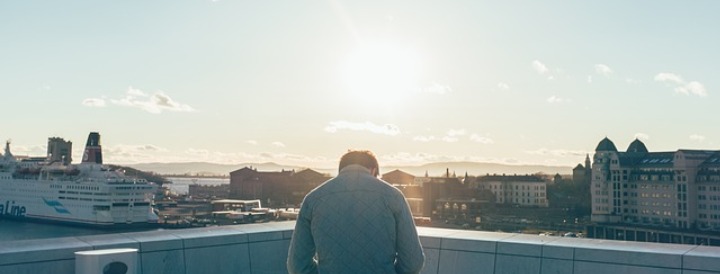
Bergen
Norway’s second city is the old seaport of Bergen, whose hilly little center holds lovely old wooden buildings and a cluster of first-rate museums, not to mention lively bars and a quality seafood restaurant, the Bryggeloftet & Stuene .
Oslo Travel Guide
Despite tourist-office endeavors, OSLO retains a low profile among European cities, and even comparisons with other Scandinavian capitals are usually a little less than favorable. Inevitably, though, you’ll pass through – the main train routes heading west to the fjords, north to the Arctic, south to the coast, and east to Sweden are routed through the city – but take heart: Oslo is definitely worth seeing. The city has some of Europe’s best museums, fields a street life that surprises most first-time visitors, and helps revive travelers weary of the austere northern wilderness.
Oslo is the oldest of the Scandinavian capital cities, founded, according to the Norse chronicler Snorre Sturlason, around 1048 by Harald Hardråde. Several decimating fires and 600 years later, Oslo upped sticks and shifted west to its present site, abandoning its old name in favor of Christiania – after the seventeenth-century Danish king Christian IV responsible for the move. The new city prospered and by the time of the break with Denmark (and union with Sweden) in 1814, Christiania – indeed Norway as a whole – was clamoring for independence, something it finally achieved in 1905, though the city didn’t revert to its original name for another twenty years.
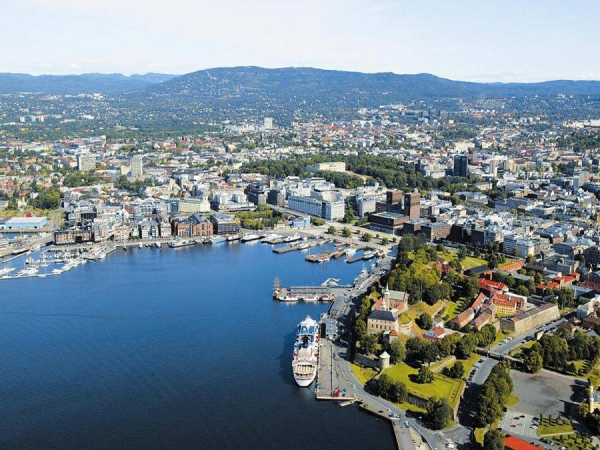
Today’s city center is largely the work of the late nineteenth and early twentieth centuries, an era reflected in the wide streets, dignified parks and gardens, solid buildings, and long, consciously classical vistas, which combine to lend it a self-satisfied, respectable air. Seeing the city takes – and deserves – time. It’s half a million inhabitants have room to spare in a city whose vast boundaries encompass huge areas of woods, sand, and water, and much of the time you’re as likely to be swimming or trail-walking as strolling the city center.
Vigeland Park, Oslo
This impressive park is visited by over 1 million visitors every year. With this number of visitors, Vigeland Park is placed on top of the most visited parks in the world. This impressive park is home to attractions such as the beautiful works of Gustav Vigeland, known as a famous Norwegian sculptor. Besides the “Monolitten” and the bronze “Sinnatagge”, more than 200 Vigeland masterpieces are placed in this lovely park.
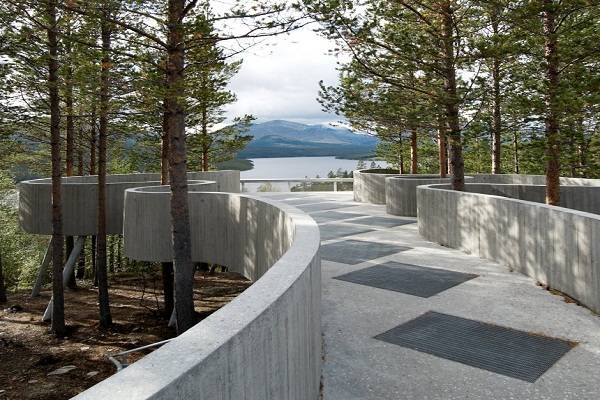
Norwegian Viewpoint to Enjoy a Spectacular Forest View
Want to enjoy a spectacular view of the forests of Norway? Why don’t you make a visit to this Norwegian viewpoint to simply enjoy a beautiful view and take some magnificent photos? It is really worth it, believe us. We can’t understand the phenomena, but there is always something special about high places from where you can simply admire a spectacular view, giving us a higher perspective on things. We want to show an unbelievable Norwegian viewpoint called Sohlbergplassen Viewpoint and designed by Carl-Viggo Hølmebakk.
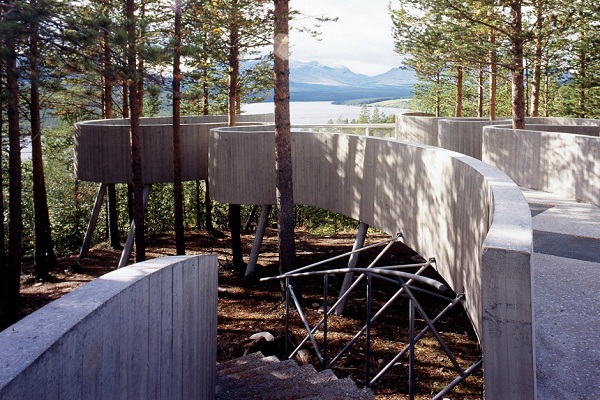
This is a geometric space, inspired by the hillside and the view of the distant mountains in the region named Stor-Elvdal, Norway. The growing pine trees on the hill where the Norwegian viewpoint is an attraction point for the tourists out there who enjoy nature. Smell the fresh air, enjoy the view, take some photos and relax your eyes; that are all you need for a perfect weekend outdoors.
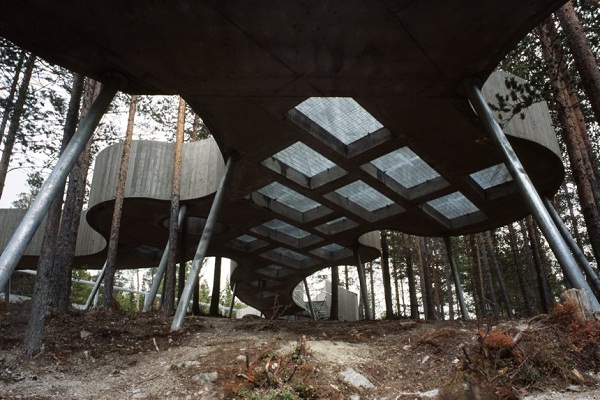
Now, believe it or not, the spectacular view you can enjoy at the Norwegian viewpoint isn’t necessarily the most interesting and impressive ingredient of the project. This project is also eco-friendly and eco-sustainable as the construction of the platform didn’t damage any trees, roots or other natural components of the environment.
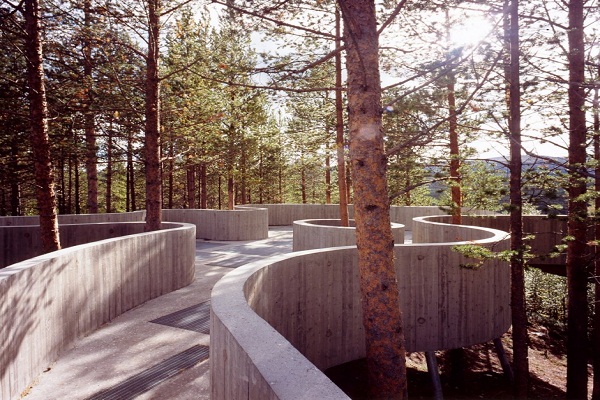
As any traditional foundation would have meant excavation and tree cutting, the architects chose another variant. The Norwegian viewpoint is supported by thin, steel pillars, drilled to solid rock in some places 12 meters below. As you can see from the pictures here there is a staircase leading to space right underneath the platform and further down the hill to the lake.
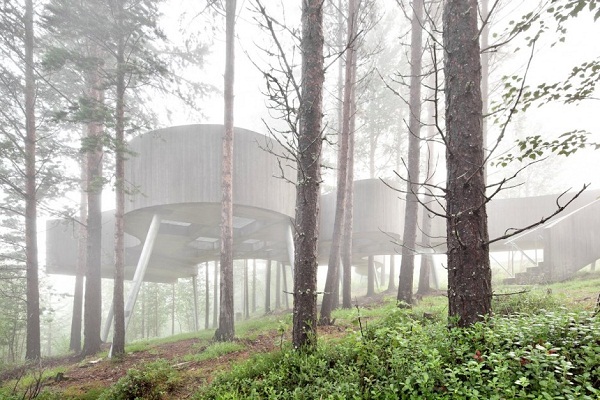
This is an eco-friendly construction placed in a dreamland specially built for those who really appreciate nature and preserving the riches of the environment.
Getting to Norway
Trains
- Åndalsnes to: Dombås (2 daily; 1hr 30min); Oslo (2 daily; 6hr 30min).
- Dombås to: Trondheim (3-4 daily; 2hr 30min).
- Kristiansand to: Kongsberg (4-5 daily; 3hr 30min); Oslo (5 daily; 5hr).
- Myrdal to: Flåm (June-Sept 11-12 daily; Oct-May 4 daily; 50min).
- Oslo to: Åndalsnes (2-3 daily; 6hr 30min); Bergen (4-5 daily; 6hr 30min); Kristiansand (4-5 daily; 5hr); Røros (2-3 daily; 6hr); Stavanger (3 daily; 9hr); Trondheim (3-4 daily; 8hr 15min); Voss (4-5 daily; 5hr 40min).
- Stavanger to: Kristiansand (3-4 daily; 3hr); Oslo (3 daily; 9hr).
- Trondheim to: Bodø (2-3 daily; 10hr); Dombås (3-4 daily; 2hr 30min); Fauske (2-3 daily; 9hr 20min); Mo-i-Rana (2-3 daily; 7hr); Oslo (3-4 daily; 7hr); Røros (1-2 daily; 2hr 30min); Stockholm (2 daily; 12hr).
Buses
- Ålesund to: Bergen (1-2 daily; 10hr); Hellesylt (1-2 daily except Sat; 2hr 40min); Molde (4-6 daily; 2hr 15min); Stryn (1-2 daily except Sat; 4hr); Trondheim (1-2 daily; 8hr 10min).
- Alta to: Hammerfest (1-2 daily except Sat; 3hr); Honningsvåg (late June to mid-Aug 1-2 daily except Sat; 5hr); Kautokeino (1-2 daily except Sat; 2hr 30min); Tromsø (April to late Oct 1-2 daily; 7hr).
- Åndalsnes to: Geiranger (mid-June to late Aug 2 daily; 3-4hr); Molde (3-7 daily; 1hr 30min); Ålesund (3-4 daily; 2hr 20min).
- Balestrand to: Sogndal (2 daily; 1hr 10min).
- Bergen to: Ålesund (1-2 daily; 10hr); Trondheim (1 daily; 14hr); Voss (4 daily; 1hr 45min).
- Fauske to: Bodø (2-3 daily; 1hr 10min); Narvik (2 daily; 7hr).
- Hammerfest to: Alta (1-2 daily except Sat; 3hr); Skaidi (1-2 daily except Sat; 1hr 15min).
- Honningsvåg to: Nordkapp (late June to mid-Aug 2 daily except Sat; 50min).
- Kautokeino to: Alta (1-2 daily except Sat; 2hr 30min).
- Kongsberg to: Oslo (every hour between 5am and 2am; 2hr).
- Narvik to: Alta (1 daily; 14hr); Tromsø (1-2 daily; 4hr 40min).
- Oslo to: Bergen (4-5 daily; 10hr).
- Stryn to: Bergen (2 daily; 7hr); Oslo (1 daily; 8hr 30min).
- Tromsø to: Alta (April to late Oct 1-2 daily; 7hr); Narvik (2 daily; 7hr); Nordkapp (late June to mid-Aug 1 daily except Sat; 14hr).
- Trondheim to: Ålesund (2-3 daily; 8hr); Bergen (2 daily; 14hr); Kristiansund (2-3 daily; 5hr); Stryn (2 daily; 7hr 20min).
- Voss to: Bergen (4 daily; 1hr 45min); Sogndal (2 daily; 3hr).
Catamaran ferries
- Arendal to: Oslo (July to mid-Aug 4 weekly; 6hr 45min).
- Bergen to: Balestrand (1-2 daily; 4hr); Flåm (1-2 daily; 5hr 30min); Måløy (1-2 daily; 4hr 30min); Stavanger (2-5 daily; 4hr 30min).
- Bodø to: Svolvær (1 daily except Sat; 5hr 30min).
- Narvik to: Svolvær (1 daily except Sat; 4hr).
- Stavanger to: Bergen (2-5 daily; 4hr 30min).

